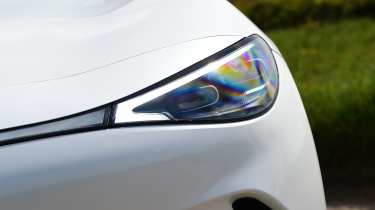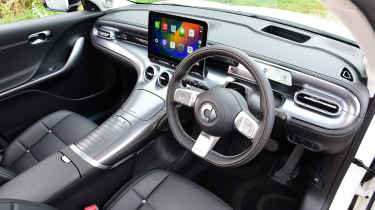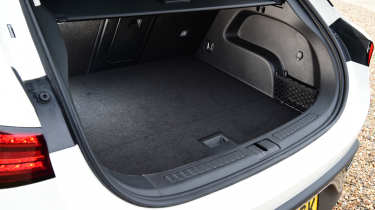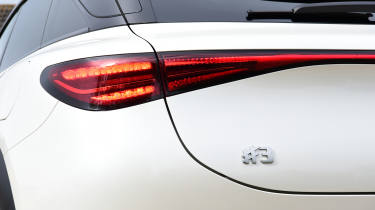Smart #3 review: a fun coupe-SUV with a few frustrations
The Smart #3 is a stylish and likeable EV for the most part, but its technology and build-quality leave a lot to be desired
Pros
- Enjoyable to drive
- Suitable for family use
- Distinctive styling
Cons
- Questionable build quality
- Poor infotainment system
- Clattery on rough roads
Smart #3 verdict
Smart has done the clever thing and listened to customer feedback when developing the #3. This mid-size coupe-SUV shares many of its parts with the #1 but Smart’s driver assistance systems are now less intrusive - even if they do still tend to badger you more than we’d like.
It may be the brand’s biggest car yet, but the #3 still provides a decent amount of driving enjoyment. There’s a plentiful amount of shove when you plant your right foot (especially in the Brabus variant) and the steering is quick, too, even if it’s also a bit vague. Smart’s new chapter isn’t off to completely smooth start, though, as the #3 is poorly built in places. The dire infotainment system certainly doesn't do it any favours when compared to its numerous rivals, either.
Details, specs and alternatives
Smart has long been famous – or infamous, depending on who you ask – for building cars that place fashion above usability. The Smart #3, on the other hand, promises to deliver both stylish looks as well as everyday practicality, as it’s a fully-fledged coupe-SUV as opposed to a two-seater city car.
Rakish coupe SUVs are big business in the current market, especially fully-electric ones. Not only do people like the slippery shape of these cars, but the rakish approach to design also helps improve range and efficiency. They still retain a good chunk of SUV practicality, too. Pricing for the Smart #3 starts from around £33,000, which means it undercuts several competitors including the Volvo EC40, BMW iX2 and Volkswagen ID.5.
Unlike the smaller #1, the Smart #3 is available with three powertrains. Entry-level Pro spec cars get a pretty potent 268bhp electric motor on the rear axle, which is powered by a 49kWh battery pack. This results in a 0-62mph time of 5.8 seconds and an electric range of 202 miles. Step up to the Pro+ or Premium model and you’ll get a larger 66kWh battery. This battery has a WLTP combined range of 283 miles in Premium form, decreasing slightly to 270 miles in the Pro+. All three variants have the same 5.8-second 0-62mph time.
If this isn’t fast enough for you, there’s also a high-performance Brabus model which gets an extra electric motor on the front axle for combined four-wheel-drive and 422bhp. Acceleration is just as rapid as you’d expect – 0-62mph takes just 3.7 seconds – however, the price you’ll pay for this is a slightly reduced range of 258 miles.
There are five Smart #3 trims in total: Pro, Pro+, Premium, 25th Anniversary Edition and Brabus. Standard kit is strong, with all Pro cars getting the 49kWh battery, LED headlights, 19-inch wheels, a 12.8-inch touchscreen, dual-zone climate control, heated front seats, a panoramic glass roof, a powered bootlid, a 360-degree camera and the brand’s ‘Smart Pilot’ driver assistance system at no extra cost.
Step up to the Pro+ and this nets you the larger 66kWh battery, electric leather seats and a wireless smartphone charger – this is our pick of the line-up. Premium cars take things a step further with a head-up display, an upgraded Beats sound system, a heat pump, autonomous parking and ambient lighting, but we wouldn’t spend the extra cash.
Smart will is also offering a 25th Anniversary Edition that features a plethora of red accents and exclusive badging. Finally, the range-topping Brabus also gets red accents, as well as a more aggressive bodykit and 20-inch alloys.
Range, battery size & charging
| Model | Range | Wallbox charge time | Rapid charge |
| Pro | 202 miles | 7hrs 30mins (0-100%, 7.4kW) | <30mins (10-80%, 130kW) |
| Pro+ | 270 miles | 12hrs 45mins (0-100%, 7.4kW) | <30mins (10-80%, 150kW) |
| Premium | 283 miles | 12hrs 45mins (0-100%, 7.4kW) | <30mins (10-80%, 150kW) |
| Brabus | 258 miles | 12hrs 45mins (0-100%, 7.4kW) | <30mins (10-80%, 150kW) |
The majority of Smart #3s get the same 66kWh battery that also features in the smaller Smart #1. However, the entry-level #3 Pro is the odd one out with its 49kWh battery, and this offers a WLTP combined range of up to 202 miles – we’d steer clear of this, unless you solely plan to drive the #3 around town.
Thanks to the #3’s slippery shape, 66kWh models have a slightly longer range than the #1; Smart says you can expect a range of up to 283 miles – 10 miles farther than the equivalent #1 – while the #3 Brabus claims up to 258 miles before needing to be plugged-in.
Of course, these figures have been achieved during lab testing, and we doubt you’ll get close to the Brabus’s claimed range figure if you’re making use of all the power that’s on offer. We managed to return an average of 3.5 miles per kilowatt-hour on our test drive of the 66kWh Premium model, which translates to a range of about 236 miles – 47 miles down on Smart’s claim. Top models get a heat pump which should help you get close to the headline stats in the winter months, though.
When the battery does eventually run dry, the Smart #3 can rapid charge at speeds of up to 150kW; find a suitable public charger and this means a 10-80% top-up of the battery in under 30 minutes – even in the base car which maxes out at 130kW. Of course, if you’re using a home wallbox, it’ll take significantly longer; our estimate is just under 13 hours for a full charge for cars with the 66kWh battery.
Running costs & insurance
The Smart #3 starts from under £33,000 if you opt for the Pro trim and steer well clear of the options list. At the other end of the scale you’ll find the hot Brabus version which kicks off at around £45,500. This means the entry-level car manages to undercut a number of similarly-sized rivals, as it sits more in line price-wise with the likes of the smaller Jeep Avenger and Peugeot E-2008. This, combined with the usual savings you can expect from EV ownership means the Smart #3 will be an appealing proposition to those who appreciate value-for-money above all else.
Something to bear in mind is that while the Smart’s electric powertrain will save company car drivers cash thanks to its 2% Benefit-in-Kind rating, and everyone else a few pennies thanks to its zero rating for VED road tax until April 2025, the sheer amount of power that it offers means the #3 is pricey to insure. The entry-level Pro model sits in insurance group 33, and this number rises all the way up to group 41 for the Brabus.
Performance, motor & drive
| Model | 0-62mph | Top speed | Driven wheels | Power |
| 49kWh | 5.8s | 112mph | Rear | 278bhp |
| 66kWh | 5.8s | 112mph | Rear | 278bhp |
| Brabus | 3.7s | 112mph | Four | 422bhp |
Don’t let the Smart #3’s performance figures or sleek shape fool you: this is not an all-out driver’s car. Don’t get us wrong, the point-and-squirt performance in even the base rear-wheel-drive model is intoxicating, let alone the ballistic manner of the top-of-the-line Brabus. As you’d probably expect, though, this performance will come at the cost of battery range.
This 1.8-tonne SUV does a respectable job of keeping body roll under control when you aim it towards the bends. The steering is quick, too, but we found that an element of guesswork was needed due to the vagueness. There is a decent amount of fun to be had overall, though.
One particular qualm we have is regarding the Smart #3’s regenerative braking setup. There’s a disconcerting delay between you lifting off the accelerator and the regenerative braking kicking in, meaning it’s difficult to get accustomed to. This problem remains even in the strongest ‘E-Pedal’ setting which still doesn’t slow the car down enough to enable full one-pedal driving.
The UK’s roads seem a little too much for the suspension to quietly handle, as things become noticeably clattery when the going gets rough. On the plus side, the #3 does smooth out the big bumps rather well. Wind and tyre noise does get a bit intrusive at higher speeds, though.
Interior, dashboard & infotainment
The Smart #3’s interior is as smart, clean and modern as its exterior; it’s very light, thanks to the standard-fit glass roof, and it’s clear Smart has certainly been rummaging in the parts bin when it comes to the #3’ switchgear – thankfully, though, it’s the Mercedes-Benz bin, which means the majority looks suitably premium. Unfortunately, it would appear that Smart isn’t quite as fastidious as Merc when it comes to assembly, as the fit and finish in some areas is very flimsy. A number of nasty-feeling bits of trim accompany the posh switchgear, too, Notably the rattly centre console storage lid which would look right at home in a cheap flat-pack kitchen.
As is customary nowadays, most of the Smart’s controls centre around a large touchscreen mounted on the dashboard. It may be the centrepiece, but this infotainment system is by far one of the #3’s biggest flaws. We found the screen fiddly to use, as a result of how cluttered many of the menus are, and slow to respond. On top of this, the software froze completely on more than one occasion. The fussy layout can at least be solved by using Apple CarPlay or Android Auto, both of which come as standard across the line-up.
Another issue lies with Smart’s Big Brother-esque driver assistance system. We say ‘driver assistance’, but what we really mean is ‘driver surveillance’ as it does have a tendency to immediately start beeping at you whenever you take your eyes off the road – even if just to turn your head at a junction or take a drink of water. Don’t get us wrong, it’s less strict than the setup in the Smart #1, but still pretty frustrating nonetheless.
Boot space, seating & practicality
| Length | Width | Height | Boot space (seats up/down) |
| 4,440mm | 1,844mm | 1,556mm | 370/1,160 litres |
The Smart #3, despite sharing its underpinnings with the #1 and Volvo EX30, is quite a bit larger than both of those cars. This means that despite the sloping roofline, the sacrifices in practicality over Smart’s other SUV model aren’t quite as drastic as you might expect. There’s plenty of space to seat two adults in the back, while the flat floor means an occasional third passenger will have room for their feet.
With a capacity of 370 litres, the #3’s boot appears, at face value, to be quite a bit smaller than the #1’s 411-litre load area. In practice, however, the usable space on offer is roughly the same, with sufficient room for the weekly shop or a couple of cabin bags for a weekend away.
Reliability & safety rating
The Smart #3 and its smaller sibling, the #1, both sit on all-new underpinnings, so it’s pretty hard to gauge reliability at this stage. What we can say is that electric cars should, in theory, be more reliable than their petrol and diesel counterparts due to having fewer moving parts to go wrong. Smart offers the #3 with a three-year, 30,000-mile comprehensive service package as standard, which includes all maintenance, while the battery pack is covered separately for up to eight years and 125,000 miles.
Euro NCAP awarded the Smart #3 with a full five-star safety rating after carrying out its increasingly stringent tests. All Smart #3 models come as standard with safety equipment including that rather over-sensitive fatigue-detection camera, autonomous emergency braking (AEB), adaptive cruise control and automatic high beams.










